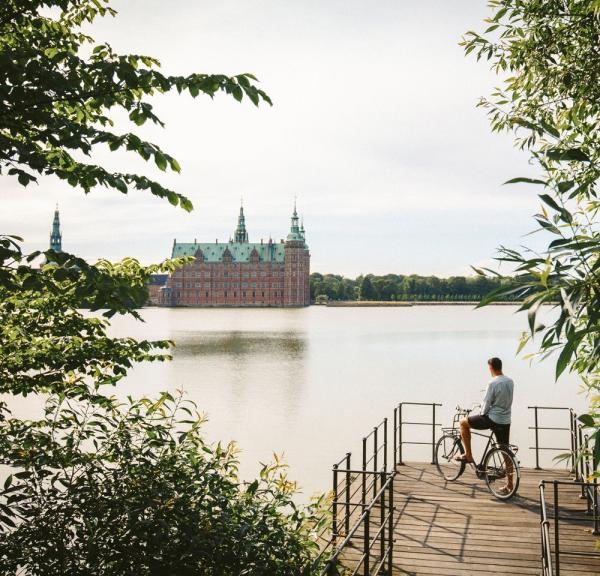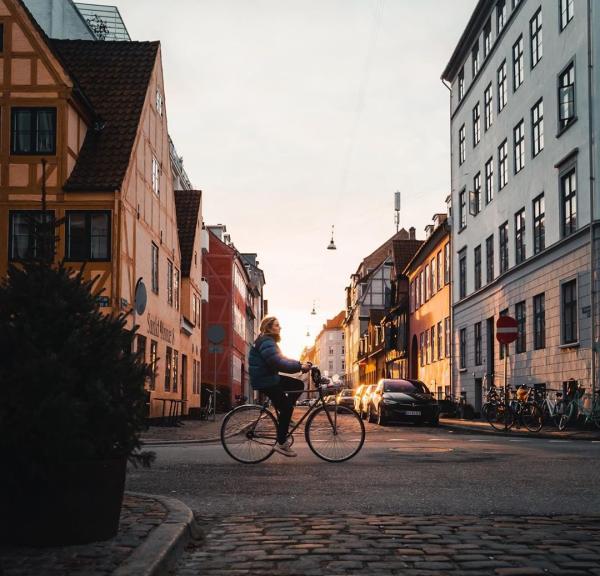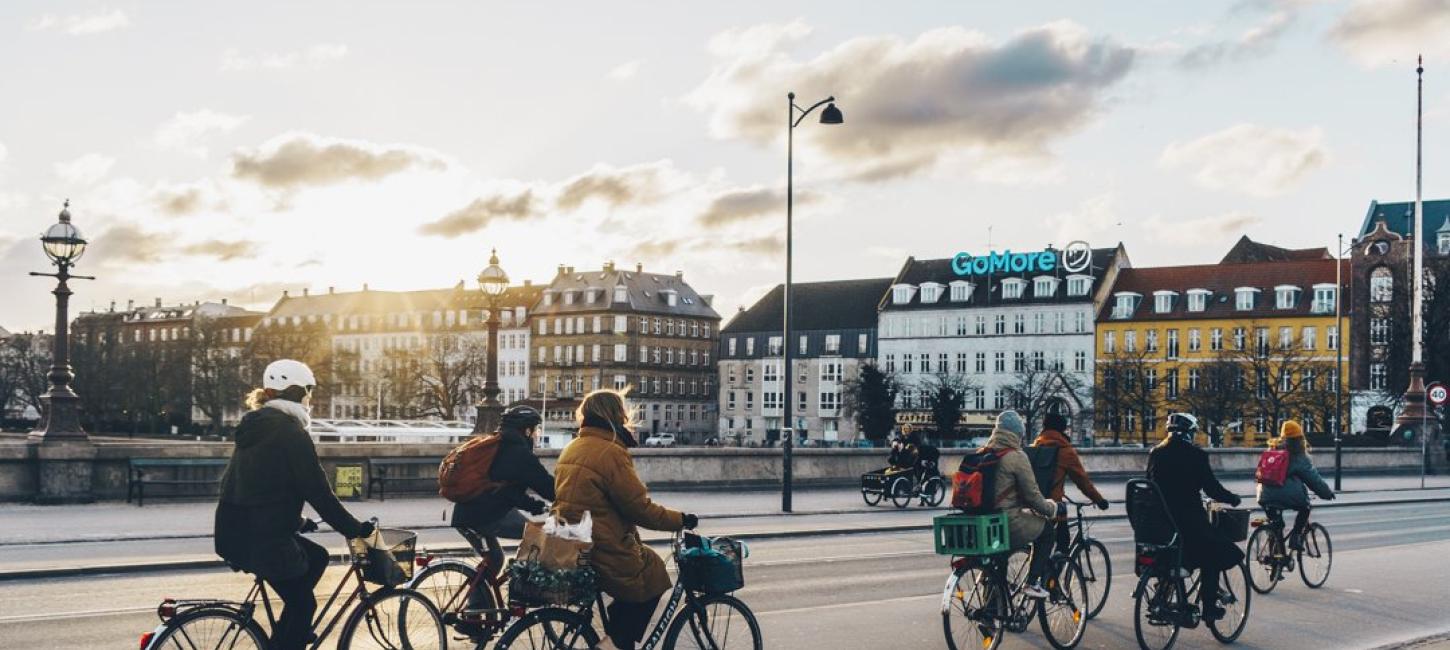10 reasons to cycle in Denmark
You might know Denmark as the homeland of the Vikings. You might also know it as one of the happiest nations on earth. We know it as a bike-lovers paradise, and here are a few reasons why.
1. Everybody’s doing it.
Cycling is a way of life in Denmark – and if you cycle every day, you’ll find like-minded people everywhere. We even have our own cycling embassy, designed to promote and inspire cycling.
2. Cycling is a great way to see the country.
It also pairs well with lots of pursuits: you can explore breweries, smoke houses and outstanding Nordic restaurants, take in beaches and castles or follow the path of the Vikings as you go.
3. The terrain is on your side.
Denmark’s highest point is only 170.89 ft above sea level.
Foto:Thomas Høyrup Christensen - Copenhagen Media Center
4. But if you want to push yourself, head to Vejle in southeast Jutland.
The town is home to the professional cyclist stage race PostNord Danmark, and is known for its short explosive hill climbs. There are also mountain bike trails in Danish forests and a growing number of gravel tracks are springing up around the country.

Foto:Kenneth Stjernegaard, VisitVejle
5. Urban cycling rules in Copenhagen.
There are more bikes than people in Denmark’s capital city, and half the population gets to school and work on two wheels. But cycling isn’t just a feature of Copenhagen – Danes cycle all across the country, and Odense is another city tipped as a cycling city of the future.
6. Bike rental is easy – not just in Copenhagen, but all across the country.
Cities also offer on-street bike rental options as well as bike shops who can rent you touring bikes, cargo bikes and just about everything else. In Denmark, cycling is just part of the culture.


7. Week or two-week long trips are easy to plan.
We have over 12,000 km of cycle lanes in national, regional and local routes plus accommodation specially designed for cyclists. If you’re looking for a cycling holiday in Denmark, our routes make it easy to plan. There are also some particularly special architecturally-designed shelters you can stay in – for a handful of coins each night – that you can only access if you arrive by bike, kayak or on foot.
8. You can do it your way.
That means lycra-clad and going for distance and speed if you like, or keeping the curious Danish feeling of hygge in mind, which, while cycling, really means going at a more relaxed pace.
9. It’s good for you and the planet.
Biking in and around Denmark offers an easy way to stay fit and healthy with a low-to-nonexistent carbon footprint.


10. Le Grand Départ – the start of the Tour de France – will be in Denmark in 2022.
The world’s best cyclists will be converging on Copenhagen and exploring routes out from the city. And if it’s good enough for them…

Foto:Robin Skjoldborg
Practical information about cycling in Denmark
What is it like cycling in Denmark?
Denmark is a mostly flat country with over 400 islands, fantastic bread, beer and pastries, a cycling-mad capital city and more than 12,000km of bike routes that make cycling in Denmark a delight. We don’t have much in the way of hills here, but we’re a little more undulating than the Netherlands, and you might well have a bit of wind to content with too (it’s character building!).
FAQs about cycling in Denmark
What are the rules when cycling in Denmark? How do I navigate and find my way around Denmark on two wheels? And which cycle route should I explore? These are some of our frequently asked questions, and if you were wondering the same, you might find some useful information below.
Fahrrad - Gesetze und Regeln
Sicherheit & Beleuchtung:
- Ein Fahrrad muss immer mit einer Klingel, einem weißen Reflektor vorn, gelben Reflektoren an den Pedalen, gelben Reflektoren an den Speichen (oder alternativ weißen Reflektoren an den Reifen bzw. Felgen) sowie einem roten Reflektor hinten ausgerüstet sein.
- Ein Zweirad muss mindestens ein Vorder- und ein Rücklicht haben.
- Ein Fahrradlicht muss aus mindestens 300 Metern Entfernung zu erkennen sein, ohne zu blenden. Die Lampe muss auch von der Seite erkennbar sein. Das Vorderlicht muss weiß, bläulich oder gelblich, das Rücklicht rot sein.
- Alle Fahrräder müssen zwischen Sonnenunter- und Sonnenaufgang sowie bei schlechter Sicht wie Nebel oder Schnee Licht anhaben.
- Ein Radanhänger mit zwei Reifen muss zwei weiße Reflektoren vorne, zwei rote Reflektoren hinten sowie je zwei gelbe Reflektoren an der Seite haben. Nach Einbruch der Dunkelheit muss ein rotes Hinterlicht hinten oder an der linken Seite angebracht sein.
Transport von Kindern auf dem Rad:
- Kinder unter sechs Jahren dürfen nur gemeinsam mit einer mindestens 15 Jahre alten Begleitperson am Straßenverkehr teilnehmen.
- Erwachsene Radfahrer (über 15 Jahre) dürfen bis zu zwei Kinder unter acht Jahren auf dem Rad transportieren.
- In einem Fahrradanhänger (der für den Kindertransport gedacht ist), dürfen bis zu zwei Kinder ohne Altersbegrenzung befördert werden.
Verkehrsregeln:
- Radfahrer müssen sich immer in Fahrtrichtung ganz rechts halten.
- Vor einer Kreuzung müssen Radfahrer, die geradeaus fahren oder nach links abbiegen möchten, auch weiterhin auf der rechten Fahrbahnseite bleiben. Ist eine Rechtsabbiegespur vorhanden, darf man an der Markierung zwischen dieser und der nächsten Geradeausspur stehenbleiben.
- Radfahrer, die an einer Kreuzung links abbiegen möchten, müssen zunächst geradeaus fahren bis zur gegenüberliegenden Ecke und den Geradeausverkehr passieren lassen, ehe sie ihre Fahrt fortsetzen.
- Radfahren auf Bürgersteigen und Wegen ist untersagt. Ausnahmen sind beschildert.
- Beim Rechts- und Linksabbiegen sowie beim Anhalten muss ein klares Handzeichen gegeben werden.
- Während der Fahrt dürfen Radfahrer nicht mit dem Handy in der Hand telefonieren.
Helm:
- Eine Helmpflicht für Radfahrer besteht in Dänemark nicht.
Mehr über die Regeln zum Radfahren in Dänemark (auf Dänisch).
Finden Sie Informationen über den Transport in Bus und Bahn mit dem Fahrrad hier.
Cycle guides and maps
A good bike and a good cycling guide are the first two steps towards a successful cycling holiday. The Danish Cycling Federation has a large selection of guides and maps available to buy online.
Bike maps
You can plan your bike route online with the Naviki app and website, available in multiple language versions.
Clearly sign-posted cycle routes
You will find it easy to navigate whilst cycling in Denmark, as the country has over 11,000km of sign-posted routes. Just find your route name, number or logo and follow the signs. Routes criss-cross each other, so it is possible to combine routes and take in the entire country by bike.
Cycle routes are particularly safe in comparison to other countries and national cycle routes tend to follow smaller by-roads, undisturbed forest roads and pathways.
National cycle routes
There are 11 national cycle routes in Denmark, which cover a total of over 4,000km. National routes are signposted with a white route number in a red square and bicycle symbol on a blue, square sign. (Note that Route 10 on Bornholm has a green, rather than blue, background). Odd route numbers 1 to 9 run North to South, while even routes 2 to 8 run East to West. There are two circular routes: Bornholm (Route 10) and the Limfjord Route (Route 12).
Regional and local routes
Denmark also has an extensive network of regional and local cycle routes, each with their own signage. The regional route signs follow the same patterns as the national; white route numbers from 16 to 99 on a blue background. The local route network also uses the same system but with numbers from 100 to 999.

